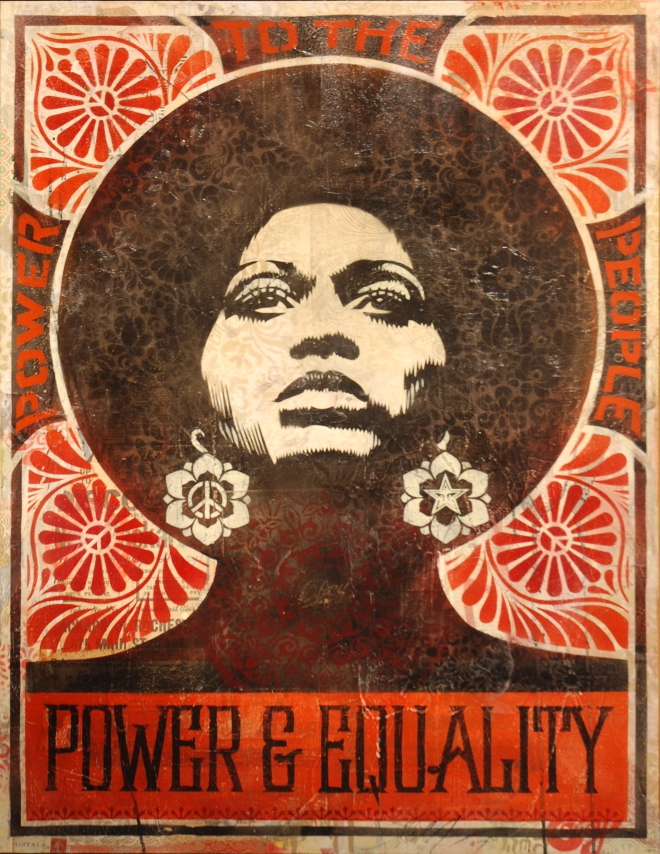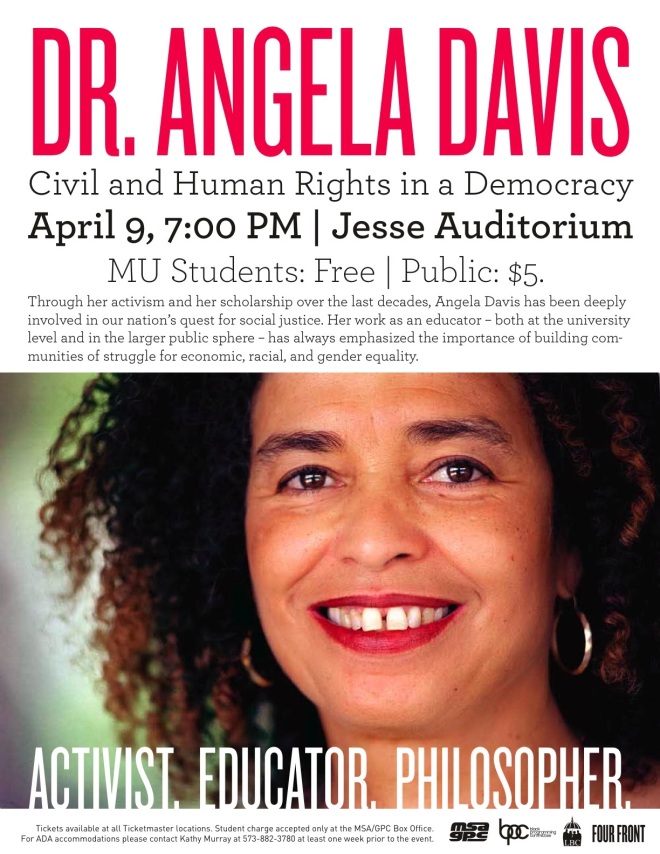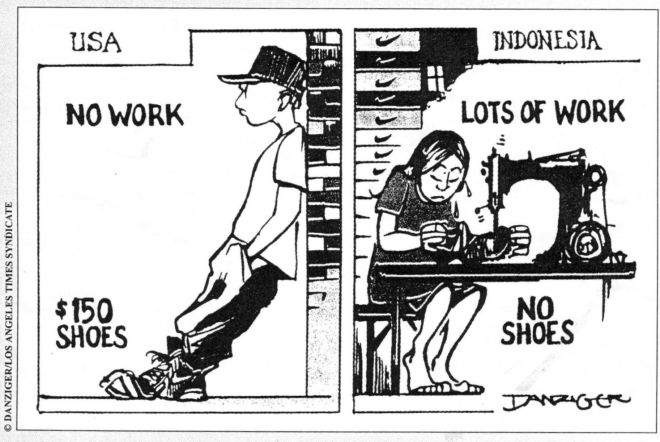* * * * *
ANGELA DAVIS in The Meaning of Freedom.
* * * * *
"Beware of those leaders and theorists who eloquently rage against white supremacy but identify black gay men and lesbians as evil incarnate. Beware of those leaders who call upon us to protect our young black men but will beat their wives and abuse their children and will not support a woman's right to reproductive autonomy. Beware of those leaders! And beware of those who call for the salvation of black males but will not support the rights of Caribbean, Central American, and Asian immigrants, or who think that struggles in Chiapas or in Northern Ireland are unrelated to black freedom! Beware of those leaders!
Regardless of how effectively (or inneffectively) veteran activists are able to engage with the issues of our times, there is clearly a paucity of young voices associated with black political leadership. The relative invisibility of youth leadership is a crucial example of this crisis in contemporary black social movements. On the other hand, within black popular culture, youth are, for better or for worse, helping to shape the political vision of their contemporaries. Many young black performers are absolutely brilliant. Not only are they musically dazzing, they are also trying to put forth anti-racist and anti-capitalist critiques. I'm thinking, for example, about Nefertiti, Arrested Development, The Fugees, and Michael Franti..."
Listen to Fugee's The Score (Full Album)
* * * * *
"There are already one million in prison in the United States. This does not include the 500.000 in city and county jails, the 600.000 on parole, and the 3 million people on probation. It also does not include the 60.000 young people in juvenile facilities, which is to say, there are presently more than FIVE MILLION people either incarcerated, on parole, or on probation... Not only is the duration of imprisonment drastically extended, it is rendered more repressive than ever. Within some state prison systems, weights have even been banned. Having spent time in several jails myself, I know how important it is to exercise the body as well as the mind. The barring of higher education and weight sets implies the creation of an incarcerated society of people who are worth little more than trash to the dominant culture.
Who is benefiting from these ominous new developments? There is already something of a boom in the prison construction industry. New architectural trends that recapitulate old ideas about incarceration such as Jeremy Bentham's panopticon have produced the need to build new jails and prisons - both public and private prisons. And there is the dimension of the profit drive, with its own exploitative, racist component. It's also important to recognize that the steadily growing trend of privatization of U.S. jails and prisons is equally menacing... We therefore ask: How many more black bodies will be sacrified on the altar of law and order?
The prison system as a whole serves as an apparatus of racist and political repression... the fact that virtually everyone behind bars was (and is) poor and that a disproportionate number of them were black and Latino led us [the activists] to think about the more comprehensive impact of punishment on communities of color and poor communities in general. How many rich people are in prison? Perhaps a few here and there, many of whom reside in what we call country club prisons. But the vast majority of prisoners are poor people. A disproportionate number of those poor people were and continue to be people of color, people of African descent, Latinos, and Native Americans.
Some of you may know that the most likely people to go to prison in this country today are young African American men. In 1991, the Sentencing Project released a report indicating that 1 in 4 of all young black men between the ages of 18 and 24 were incarcerated in the United States. 25% is an astonishing figure. That was in 1991. A few years later, the Sentencing Project released a follow-up report revealing that within 3 or 4 years, the percentage had soared to over 32%. In other words, approximately one-third of all young black men in this country are either in prison or directly under the supervision and control of the criminal justice system. Something is clearly wrong."
(pg. 25, 27 and 38)
* * * * *
"When a child's life is forever arrested by one of the gunshots that are heard so frequently in poor black and Latino communities, parents, teachers, and friends parede in demonstrations bearing signs with the slogan 'STOP THE VIOLENCE.' Those who live with the daily violence associated with drug trafficking and increasing use of dangerous weapons by youth are certainly in need of immediate solutions to these problems. But the decades-old law-and-order solutions will hardly bring peace to poor black and Latino communities. Why is there such a paucity of alternatives? Why the readiness to take on a discourse and entertain policies and ideological strategies that are so laden with racism?
Ideological racism has begun to lead a secluded existence. It sequesters itself, for example, within the concept of crime. (...) I, for one, am of the opinion that we will have to renounce jails and prisons as the normal and unquestioned approaches to such social problems as drug abuse, unemployment, homelessness, and illiteracy. (...) When abolitionists raise the possibility of living without prisons, a common reaction is fear - fear provoked by the prospect of criminals pouring out of prisons and returning to communities where they may violently assault people and their property. It is true that abolitionists want to dismantle structures of imprisonment, but not without a process that calls for building alternative institutions. It is not necessary to address the drug problem, for example, within the criminal justice system. It needs to be separated from the criminal justice system. Rehabilitation is not possible within the jail and prison system.
We have to learn how to analyze and resist racism even in contexts where people who are targets and victims of racism commit acts of harm against others. Law-and-order discourse is racist, the existing system of punishment has been deeply defined by historical racism. Police, courts, and prisons are dramatic examples of institutional racism. Yet this is not to suggest that people of color who commits acts of violence against other human beings are therefore innocent. This is true of brothers and sisters out in the streets as well as those in the high-end suites... A victim of racism can also be a perpetrator of sexism. And indeed, a victim of racism can be a perpetrator of racism as well. Victimization can no longer be permitted to function as a halo of innocence."
(pg. 29 - 31)
* * * * *
"Black people have been on the forefront of radical and revolutionary movements in this country for several centuries. (...) Not all of us have given up hope for revolutionary change. Not all of us accept the notion of capitalist inevitability based on the collapse of socialism. Socialism of a certain type did not work because of irreconcilable internal contradictions. Its structures have fallen. But to assume that capitalism is triumphant is to use a simplistic boxing-match paradigm. Despite its failure to build lasting democratic sctructures, socialism nevertheless demonstrated its superiority over capitalism on several accounts: the ability to provide free education, low-cost housing, jobs, free child care, free health care, etc. This is precisely what is needed in U.S. black communities... and among poor people in general. Harlem furnishes us with a dramatic example of the future of late capitalism and compelling evidence of the need to reinvigorate socialist democratic theory and practise - for the sake of our sisters and brothers who otherwise will be thrown into the dungeons of the future, and indeed, for the sake of us all.
During the McCarthy era, communism was established as the enemy of the nation and came to be represented as the enemy of the "free world". During the 1950s, when membership in the Communist Party of U.S.A. was legally criminalized, many members were forced underground and/or were sentenced to many years in prison. In 1969, when I was personally targeted by anti-communist furor, black activists in such organizations as the Black Panther Party were also singled out. As a person who represented both the communist threat and the black revolutionary threat, I became a magnet for many forms of violence... If we can understand how people could be led to fear communism in such a visceral way, it might help us to apprehend the ideological character of the fear of the black criminal today.
The U.S. war in Vietnam lasted as long as it did because it was fueled by a public fear of communism. The government and the media led the public to believe that the Vietnamese were their enemy, as if it were the case that the defeat of the racialized communist enemy in Vietnam would ameliorate U.S. people's lives and make them feel better about themselves..."
(To know more about the Vietnam war, please watch Peter Davis' Oscar-winning documentary Hearts and Minds)
* * * * *
"The connection between the criminalization of young black people and the criminalization of immigrants are not random. In order to understand the structural connections that tie these two forms of criminalization together, we will have to consider the ways in which global capitalism has transformed the world. What we witnessed at the close of the 20th century is the growing power of a circuit of transnational corporations that belong to no particular nation-state, that are not expected to respect the laws of any given nation-state, and that move across borders at will in perpetual search of maximizing profits.
Let me tell you a story about my personal relationship with one of these transnational corporations - Nike. My first pair of serious running shoes were Nikes. Over the years I became so attached to Nikes that I convinced myself that I could not run without wearing them. But once I learned about the conditions under which these shoes are produced, I could not in good conscience buy another pair of their running shoes. It may be true that Michael Jordan and Tiger Woods had multimillion-dollar contracts with Nike, but in Indonesia and Vietnam Nike has been creating working conditions that, in many respects, resemble slavery.
Not long ago there was an investigation of the Nike factory in Ho Chi Minh City, and it was discovered that the young women who work in Nike's sweatshops there were paid less than the minimum wage in Vietnam, which is only U$2.50 a day... Consider what you pay for Nikes and the vast differential between the price and the workers' wages. This differential is the basis for Nike's rising profits. (...) If you read the entire report, you will be outraged to learn of the abominable treatment endured by the young women and girls who produce the shoes and the apparel we wear. The details of the report include the fact that during an 8-hour shift, workers are able to use the toilet just once, and they are prohibited from drinking water more than twice. There is sexual harrasment, inadequate health care, and excessive overtime... Perhaps we need to discuss the possibility of an organized boycott... but given the global reach of corporations like Nike, we need to think about a global boycott.
Corporations move to developing countries because it is extremely profitable to pay workers U$2.50 a day or less in wages. That's U$2.50 a day, not U$2.50 a hour, which would still be a pittance. (...) The corporations that have migrated to Mexico, Vietnam, and other Third World countries also often end up wreaking havoc on local economies. They create cash economies that displace subsistence economies and produce artificial unemployment. Overall, the effect of capitalist corporations colonizing Third World countries is one of pauperization. These corporations create poverty as surely as they reap rapacious profits."
(pg. 44-46)
* * * * *
You might also like:
- Recommended documentary: "Free Angela And All Political Prisoners" (2012, download [1.16gb])
* * * * *
All quotes in this post from...
Angela Y. Davis (1944 - )
The Meaning of Freedom
And Other Difficult Dialogues
And Other Difficult Dialogues
San Francisco, California. 2012.
Tweet










Nenhum comentário:
Postar um comentário